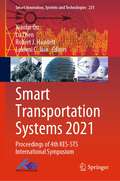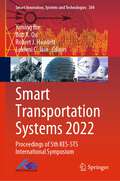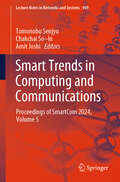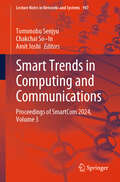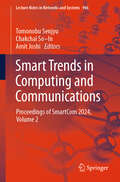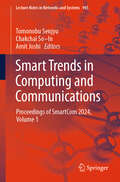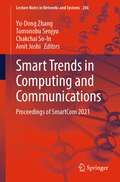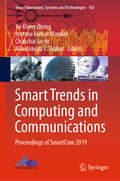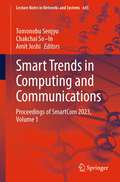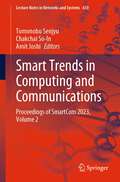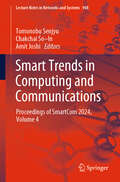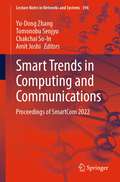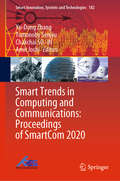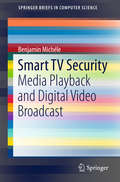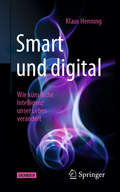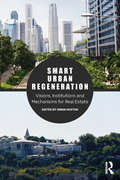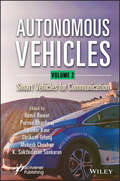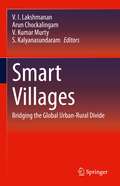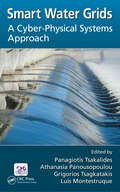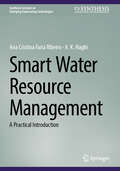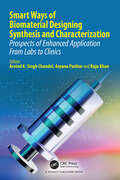- Table View
- List View
Smart Transportation Systems 2020: Proceedings of 3rd KES-STS International Symposium (Smart Innovation, Systems and Technologies #185)
by Lakhmi C. Jain Robert J. Howlett Xiaobo Qu Lu ZhenThis book gathers selected papers presented at the KES International Symposium on Smart Transportation Systems (KES STS 2020). Modern transportation systems have undergone a rapid transformation in recent years, producing a range of technological innovations such as connected vehicles, self-driving cars, electric vehicles, Hyperloop, and even flying cars, and with them, fundamental changes in transport systems around the world. The book discusses current challenges, innovations, and breakthroughs in smart transportation systems, as well as transport infrastructure modeling, safety analysis, freeway operations, intersection analysis, and other related cutting-edge topics.
Smart Transportation Systems 2021: Proceedings of 4th KES-STS International Symposium (Smart Innovation, Systems and Technologies #231)
by Xiaobo Qu Lu Zhen Robert J. Howlett Lakhmi C. JainThis book gathers selected papers presented at the KES International Symposium on Smart Transportation Systems (KES-STS 2021). Modern transportation systems have undergone a rapid transformation in recent years, producing a range of technological innovations such as connected vehicles, self-driving cars, electric vehicles, Hyperloop, and even flying cars, and with them, fundamental changes in transport systems around the world. The book discusses current challenges, innovations, and breakthroughs in smart transportation systems, as well as transport infrastructure modelling, safety analysis, freeway operations, intersection analysis, and other related cutting-edge topics.
Smart Transportation Systems 2022: Proceedings of 5th KES-STS International Symposium (Smart Innovation, Systems and Technologies #304)
by Yiming Bie Bob X. Qu Robert J. Howlett Lakhmi C. JainThis book gathers selected papers presented at the KES International Symposium on Smart Transportation Systems (KES STS 2022). Modern transportation systems have undergone a rapid transformation in recent years, producing a range of technological innovations such as connected vehicles, self-driving cars, electric vehicles, Hyperloop, and even flying cars, and with them, fundamental changes in transport systems around the world. The book discusses current challenges, innovations, and breakthroughs in smart transportation systems, as well as transport infrastructure modeling, safety analysis, freeway operations, intersection analysis, and other related cutting-edge topics.
Smart Transportation Systems 2023: Proceedings of 6th KES-STS International Symposium (Smart Innovation, Systems and Technologies #356)
by Yiming Bie Kun Gao Robert J. Howlett Lakhmi C. JainThis book gathers selected papers presented at the KES International Symposium on Smart Transportation Systems (KES STS 2023). Modern transportation systems have undergone a rapid transformation in recent years, producing a range of technological innovations such as connected vehicles, self-driving cars, electric vehicles, Hyperloop, and even flying cars, and with them, fundamental changes in transport systems around the world. The book discusses current challenges, innovations, and breakthroughs in smart transportation systems, as well as transport infrastructure modeling, safety analysis, freeway operations, intersection analysis, and other related cutting-edge topics.
Smart Transportation Systems 2024: Proceedings of 7th KES-STS International Symposium (Smart Innovation, Systems and Technologies #407)
by Kun Gao Yiming Bie R. J. Howlett Lakhmi C. JainThis book gathers selected papers presented at the KES International Symposium on Smart Transportation Systems (KES STS 2024). Modern transportation systems have undergone a rapid transformation in recent years, producing a range of technological innovations such as connected vehicles, self-driving cars, electric vehicles, Hyperloop, and even flying cars, and with them, fundamental changes in transport systems around the world. The book discusses current challenges, innovations, and breakthroughs in smart transportation systems, as well as transport infrastructure modeling, safety analysis, freeway operations, intersection analysis, and other related cutting-edge topics.
Smart Trends in Computing and Communications: Proceedings of SmartCom 2024, Volume 5 (Lecture Notes in Networks and Systems #949)
by Amit Joshi Tomonobu Senjyu Chakchai So–InThis book gathers high-quality papers presented at the Eighth International Conference on Smart Trends in Computing and Communications (SmartCom 2024), organized by Global Knowledge Research Foundation (GR Foundation) from 12 to 13 January 2024 in Pune, India. It covers the state-of-the-art and emerging topics in information, computer communications, and effective strategies for their use in engineering and managerial applications. It also explores and discusses the latest technological advances in, and future directions for, information and knowledge computing and its applications.
Smart Trends in Computing and Communications: Proceedings of SmartCom 2024, Volume 3 (Lecture Notes in Networks and Systems #947)
by Amit Joshi Tomonobu Senjyu Chakchai So–InThis book gathers high-quality papers presented at the Eighth International Conference on Smart Trends in Computing and Communications (SmartCom 2024), organized by Global Knowledge Research Foundation (GR Foundation) from 12 to 13 January 2024 in Pune, India. It covers the state-of-the-art and emerging topics in information, computer communications, and effective strategies for their use in engineering and managerial applications. It also explores and discusses the latest technological advances in, and future directions for, information and knowledge computing and its applications.
Smart Trends in Computing and Communications: Proceedings of SmartCom 2024, Volume 2 (Lecture Notes in Networks and Systems #946)
by Amit Joshi Tomonobu Senjyu Chakchai So–InThis book gathers high-quality papers presented at the Eighth International Conference on Smart Trends in Computing and Communications (SmartCom 2024), organized by Global Knowledge Research Foundation (GR Foundation) from 12 to 13 January 2024 in Pune, India. It covers the state-of-the-art and emerging topics in information, computer communications, and effective strategies for their use in engineering and managerial applications. It also explores and discusses the latest technological advances in, and future directions for, information and knowledge computing and its applications.
Smart Trends in Computing and Communications: Proceedings of SmartCom 2024, Volume 1 (Lecture Notes in Networks and Systems #945)
by Amit Joshi Tomonobu Senjyu Chakchai So–InThis book gathers high-quality papers presented at the Eighth International Conference on Smart Trends in Computing and Communications (SmartCom 2024), organized by Global Knowledge Research Foundation (GR Foundation) from 12 to 13 January 2024 in Pune, India. It covers the state-of-the-art and emerging topics in information, computer communications, and effective strategies for their use in engineering and managerial applications. It also explores and discusses the latest technological advances in, and future directions for, information and knowledge computing and its applications.
Smart Trends in Computing and Communications: Proceedings of SmartCom 2021 (Lecture Notes in Networks and Systems #286)
by Amit Joshi Yu-Dong Zhang Tomonobu Senjyu Chakchai So-InThis book gathers high-quality papers presented at the Fifth International Conference on Smart Trends in Computing and Communications (SmartCom 2021), organized by Global Knowledge Research Foundation (GR Foundation) from March 2 – 3 , 2021. It covers the state of the art and emerging topics in information, computer communications, and effective strategies for their use in engineering and managerial applications. It also explores and discusses the latest technological advances in, and future directions for, information and knowledge computing and its applications.
Smart Trends in Computing and Communications: Proceedings of SmartCom 2019 (Smart Innovation, Systems and Technologies #165)
by Jyotsna Kumar Mandal Yu-Dong Zhang Chakchai So-In Nileshsingh V. ThakurThis book gathers high-quality papers presented at the International Conference on Smart Trends for Information Technology and Computer Communications (SmartCom 2019), organized by the Global Knowledge Research Foundation (GR Foundation) from 24 to 25 January 2019. It covers the state-of-the-art and emerging topics pertaining to information, computer communications, and effective strategies for their use in engineering and managerial applications. It also explores and discusses the latest technological advances in, and future directions for, information and knowledge computing and its applications.
Smart Trends in Computing and Communications: Proceedings of SmartCom 2023, Volume 1 (Lecture Notes in Networks and Systems #645)
by Tomonobu Senjyu Chakchai So–In Amit JoshiThis book gathers high-quality papers presented at the Seventh International Conference on Smart Trends in Computing and Communications (SmartCom 2022), organized by Global Knowledge Research Foundation (GR Foundation) from January 24–25, 2023, in Jaipur, India. It covers the state-of-the-art and emerging topics in information, computer communications, and effective strategies for their use in engineering and managerial applications. It also explores and discusses the latest technological advances in, and future directions for, information and knowledge computing and its applications.
Smart Trends in Computing and Communications: Proceedings of SmartCom 2023, Volume 2 (Lecture Notes in Networks and Systems #650)
by Tomonobu Senjyu Chakchai So-In Amit JoshiThis book gathers high-quality papers presented at the Seventh International Conference on Smart Trends in Computing and Communications (SmartCom 2022), organized by Global Knowledge Research Foundation (GR Foundation) from January 24–25, 2023, in Jaipur, India. It covers the state-of-the-art and emerging topics in information, computer communications, and effective strategies for their use in engineering and managerial applications. It also explores and discusses the latest technological advances in, and future directions for, information and knowledge computing and its applications.
Smart Trends in Computing and Communications: Proceedings of SmartCom 2024, Volume 4 (Lecture Notes in Networks and Systems #948)
by Tomonobu Senjyu Chakchai So–In Amit JoshiThis book gathers high-quality papers presented at the Eighth International Conference on Smart Trends in Computing and Communications (SmartCom 2024), organized by Global Knowledge Research Foundation (GR Foundation) from 12 to 13 January 2024 in Pune, India. It covers the state-of-the-art and emerging topics in information, computer communications, and effective strategies for their use in engineering and managerial applications. It also explores and discusses the latest technological advances in, and future directions for, information and knowledge computing and its applications.
Smart Trends in Computing and Communications: Proceedings of SmartCom 2022 (Lecture Notes in Networks and Systems #396)
by Yu-Dong Zhang Tomonobu Senjyu Chakchai So-In Amit JoshiThis book gathers high-quality papers presented at the Sixth International Conference on Smart Trends in Computing and Communications (SmartCom 2022), organized by Global Knowledge Research Foundation (GR Foundation) in partnership with IFIP InterYIT during January 11–12, 2022. It covers the state of the art and emerging topics in information, computer communications, and effective strategies for their use in engineering and managerial applications. It also explores and discusses the latest technological advances in, and future directions for, information and knowledge computing and its applications.
Smart Trends in Computing and Communications: Proceedings of SmartCom 2020 (Smart Innovation, Systems and Technologies #182)
by Yu-Dong Zhang Tomonoby Senjyu Chakchai So–in Amit JoshiThis book gathers high-quality papers presented at the International Conference on Smart Trends for Information Technology and Computer Communications (SmartCom 2020), organized by the Global Knowledge Research Foundation (GR Foundation) from 23 to 24 January 2020. It covers the state-of-the-art and emerging topics in information, computer communications, and effective strategies for their use in engineering and managerial applications. It also explores and discusses the latest technological advances in, and future directions for, information and knowledge computing and its applications.
Smart TV Security
by Benjamin MichéleThis book discusses the emerging topic of Smart TV security, including its implications on consumer privacy. The author presents chapters on the architecture and functionality of Smart TVs, various attacks and defenses, and associated risks for consumers. This includes the latest attacks on broadcast-related digital services and built-in media playback, as well as access to integrated cameras and microphones. This book is a useful resource for professionals, researchers and students engaged with the field of Smart TV security.
Smart und digital: Wie künstliche Intelligenz unser Leben verändert
by Klaus HenningKünstliche Intelligenz verändert alles.Dieses Buch ermutigt, sich der Herausforderung durch die digitale Transformation mit Künstlicher Intelligenz zu stellen. Der Leser erfährt, warum diese Transformation als größte Kulturrevolution seit der Erfindung des Massenbuchdrucks anzusehen ist und wie diese wert-orientiert positiv gestaltet werden kann. Dabei verfolgt der Autor die These, dass Intelligente Objekte im Netz und Gegenstände dieser Welt ein eigenes Bewusstsein bekommen. Er zeigt anhand vieler Beispiele, wie diese digitalen Begleiter zu unseren digitalen Partnern werden. Dieses Sachbuch gibt viele Anregungen für das eigene Lebens- und Arbeitsumfeld und ist voller Beispiele für die Umsetzung von Systemen der künstlichen Intelligenz. Der Leser erfährt, was heute schon geht und was in den nächsten zehn bis zwanzig Jahren zu erwarten ist. Das Werk ist für alle interessant, die sich für KI und die digitale Transformation interessieren – von Verantwortlichen in Unternehmen, öffentlichen Einrichtungen und Politik, wie auch alle Lehrer und Eltern, die verstehen wollen, was die nächste Generation erwartet.
Smart Urban Regeneration: Visions, Institutions and Mechanisms for Real Estate
by Simon HustonThe role of real estate in our cities is crucial to building sustainable and resilient urban futures. Smart Urban Regeneration brings together institutional, planning and real estate insights into an innovative regeneration framework for academics, students and property professionals. Starting by identifying key urban issues within the historical urban and planning backdrop, the book goes on to explore future visions, the role of institutions and key mechanisms for smart urban regeneration. Throughout the book, international case studies and discussion questions help to draw out global implications for urban stakeholders. Real estate professionals face a real challenge to build visionary developments which resonate locally yet mitigate climate change and curb sprawl, and foster biodiversity. By avoiding the dangers of speculative excess on one side and complacency on the other, Smart Urban Regeneration shows how transformation aspirations can be achieved sustainably. Academics, students and professionals who are involved in real estate, urban planning, property investment, community development and sustainability will find this book an essential guide to smart urban regeneration investment.
Smart Vehicles for Communication: Autonomous Vehicles Volume 2
by Romil Rawat Purvee Bhardwaj Upinder Kaur Shrikant Telang Mukesh Chouhan K. Sakthidasan SankaranAUTONOMOUS VEHICLES The companion to Autonomous Vehicles Volume 1: Using Machine Intelligence, this second volume in the two-volume set covers intelligent techniques utilized for designing, controlling, and managing vehicular systems based on advanced algorithms of computing like machine learning, artificial intelligence, data analytics, and Internet of Things (IoT) with prediction approaches to avoid accidental damages, security threats, and theft. Besides communicating with other vehicles, self-driving cars connected to a 5G network will also be able to communicate with different infrastructure elements that make up our roads and other transportation and communication systems. Similarly, an unmanned aerial vehicle (UAV), an aircraft without any human pilot, crew, or passengers on board, can operate under remote control by a human operator, as a remotely-piloted aircraft (RPA), or with various degrees of autonomy. These include autopilot assistance and fully autonomous aircraft that have no provision for human intervention. Transportation is a necessary, but often painful process. With fully autonomous driving, passengers will be freed to accomplish their own goals, turning the dead hours of driving into fruitful hours of learning, working, engaging, and relaxing. Similarly, UAVs can perform functions that human-operated aircraft cannot, whether because of the environment or high-risk situations. The purpose of the book is to present the needs, designs, and applications of autonomous vehicles. The topics covered range from mechanical engineering to computer science engineering, both areas playing vital roles in programming, managing, generating alerts, and GPS position, artificial intelligence-based prediction of path and events, as well as other high-tech tools, are covered in this book, as well. Whether for the student, veteran engineer, or another industry professional, this book, and its companion volume, are must-haves for any library.
Smart Village Technology: Concepts and Developments (Modeling and Optimization in Science and Technologies #17)
by Magdi S. Mahmoud Siddhartha Sen Srikanta PatnaikThis book offers a transdisciplinary perspective on the concept of "smart villages" Written by an authoritative group of scholars, it discusses various aspects that are essential to fostering the development of successful smart villages. Presenting cutting-edge technologies, such as big data and the Internet-of-Things, and showing how they have been successfully applied to promote rural development, it also addresses important policy and sustainability issues. As such, this book offers a timely snapshot of the state-of-the-art in smart village research and practice.
Smart Villages: Bridging the Global Urban-Rural Divide
by V. I. Lakshmanan Arun Chockalingam V. Kumar Murty S. KalyanasundaramThis book brings together technical expertise, best practices, case studies and ground-level application of the ideas for empowering the rural population of the world to live economically prosperous, environmentally sustainable, and socially progressive lives, on par or comparable with the quality of life enjoyed by the global urban population. The idea of Smart Villages takes on greater urgency in light of the investments made in this millennium on “Smart Cities”, taking advantage of the technological advances, particularly in digital connectivity. These investments have and will continue to expand the urban-rural divide, unless similar investments are made in the villages as well. The book provides a much-needed guide for a holistic development of a Smart Village, by defining the need, developing the framework, and describing the delivery, complete with successful case studies. Contributors to the book, from Canada, USA, Africa and India bring years of academic, industry and governmental experience, including organization of several Smart Village conferences. The knowledge base in the book will be of great value to anyone interested in or active in rural planning, including governmental and non-governmental organizations, industrial solution providers, public healthcare professionals, public policy professionals and students, as well as rural communities around the world. Consolidates all the aspects of creating/developing a Smart Village;Delivers an effective tool-kit for practitioners in the area of Smart Villages;Provides a policy-based framework for the development of an ideal Smart Village;Illustrates, through case studies, the fulfillment of key requirements of a Smart Village;Brings together experts from around the world to share their vision of a Smart Village;Highlights the importance of balancing development with social/gender equity and cultural traditions.
Smart Water Grids: A Cyber-Physical Systems Approach
by Panagiotis Tsakalides Athanasia Panousopoulou Grigorios Tsagkatakis Luis MontestruqueThe effects of climate change, rapid urbanization, and aging infrastructure challenge water policymakers to confront a radical paradigm shift in water resources utilization. Recent advances in sensing, networking, processing, and control have provided the means for sustainable solutions in water management, and their implementation in water infrastructures is collectively referred to as "smart water grids." Smart water grids depend upon cyber-physical system principles to effectively respond to issues regarding the scalability and reliability of dynamic and inaccessible environments. As such, unique smart water grid issues associated with front-end signal processing, communication, control, and data analysis must be jointly addressed, while sophisticated techniques for data analytics must be introduced into cyber-physical systems research. This book provides a thorough description of the best practices for designing and implementing cyber-physical systems that are tailored to different aspects of smart water grids. It is organized into three distinct, yet complementary areas, namely: the theory behind water-oriented cyber-physical systems with an emphasis on front-end sensing and processing, communication technologies, and learning techniques over water data; the applications and emerging topics of cyber-physical systems for water urban infrastructures, including real-life deployments, modern control tools, and economic aspects for smart water grids; and the applications and emerging topics across natural environments, emphasizing the evolution of fresh water resources. The structured discussion yields a rich, comprehensive body of knowledge on this emerging topic of research and engineering. As water issues intensify on a global scale, this book offers an algorithmic and practical toolkit for intermediate and advanced readers as well as professionals and researchers who are active in, or interested in, learning more about smart water grids. Key Features: Emphasizes the multidisciplinary nature of this emerging topic, covering both theoretical and practical aspects of this area while providing insights on existing deployments, which can serve as design examples for new applications. Explores how modern signal processing and machine learning techniques can contribute and enrich the potential of smart water grids, well beyond conventional closed-loop control techniques. Highlights complementary aspects that will help shape the future of smart water grids, such as consumption awareness, economic aspects, and control tools in industrial water treatment as well as the impact of climate change on fresh water resources. Enables the reader to better understand this emerging topic, investing in current state-of-the-art and future technological roadmaps for smart water grids.
Smart Water Resource Management: A Practical Introduction (Synthesis Lectures on Emerging Engineering Technologies)
by A. K. Haghi Ana Cristina RibeiroAdvanced methods for water consumption management can help save water and financial resources. This book introduces efficient methods and practical approaches for water consumption management through computational modeling to forecast water demand and optimization and through smart technology to help prevent or reduce water loss using the Geographic Information Systems (GIS) and the Internet of Things (IoT). The book will be a useful for researchers and graduate students focusing on research initiatives in the field of water resource management, and for researchers and practicing engineers in water utility companies.
Smart Ways of Biomaterial Designing Synthesis and Characterization: Prospects of Enhanced Application From Labs to Clinics
by Arvind K. Singh Chandel Arpana Parihar Raju KhanThis book explores the design, synthesis, and characterization of natural and synthetic polymeric biomaterials for diverse biomedical applications, including drug delivery, tissue engineering, and antimicrobial coatings. It highlights advances in polymer chemistry, offering insights into the modification of polymers’ properties to meet biomedical challenges. The book provides detailed strategies for material design and characterization, addressing practical issues faced by researchers. It also covers crucial aspects such as materials-tissue interaction, sterilization prior to in vivo use, and the characterization of biomaterials for development. Serving as a comprehensive guide for students, researchers, and professionals in the biomedical field, this book aims to bridge the gap between laboratory research and clinical applications.

